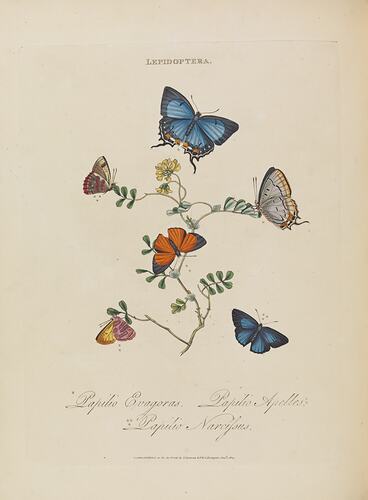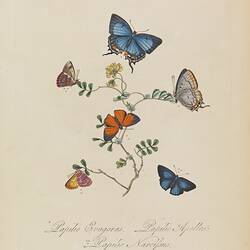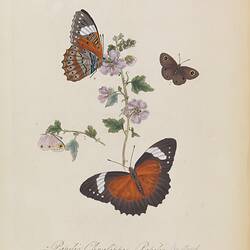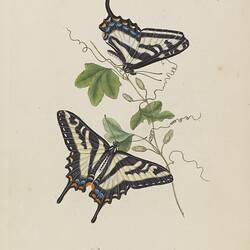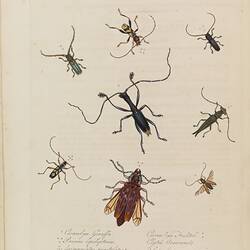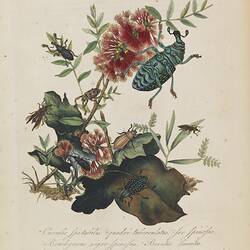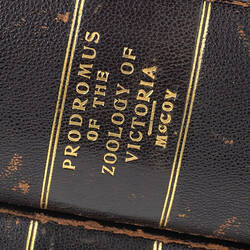Summary
Full title: 'An epitome of the natural history of the insects of New Holland, New Zealand, New Guinea, Otaheite, and other islands in the Indian, Southern, and Pacific oceans : including the figures and descriptions of one hundred and fifty three species of the more splendid, beautiful, and interesting insects, hitherto discovered in those countries, and which for the most part have not appeared in the works of any preceding author. The figures are correctly delineated from specimens of the insects; and with the descriptions are arranged according to the Linnæan system, with reference to the writings of Fabricius and other entomologists'.
This volume on insects from Australia, New Zealand, Tahiti and islands the Indian, Southern, and Pacific oceans was written, illustrated and published by Anglo-Irish naturalist Edward Donovan. Donovan was based in London and had access to the important private and public collections of the era, which included many so-called 'exotic' specimens from places such as Australia. This work is based on a number of these collections as well as the work of amateur entomologist William Jones.
Little is known about Donovan's early life, aside from that he was born in 1768 to a wealthy family. Butterfly collecting had become a popular hobby among the upper classes in the 18th century, and Donovan is an example of the 'gentleman naturalist' trend of the period. He explored a wide range of subjects, including insects, birds, fish, shells and mammals, and was a prolific collector. Though he went on several collecting trips throughout England and Wales from 1800 to 1805, he never left Britain, which is evident in his early focus on the natural history of the British Isles. Nevertheless, he later turned his attention to 'exotic' specimens and published three volumes looking at the insects of China, India and Australia, then known as New Holland in Europe.
This book is part of a three-volume set, with the first volume covering the natural history of China, and the second India. The 'New Holland' volume was only printed in the 1805 edition and is relatively rare. New editions of the 'Natural history of the insects of China' and the 'Natural history of the insects of India' were published in 1842, with updates by J. O. Westwood. Museums Victoria Library holds the 1842 edition of 'Natural history of the insects of India'.
Physical Description
1 unnumbered volume, with 41 hand-coloured engraved plates ; 30 cm. Half bound in black and green buckram. Wove papers. Tightback.
Significance
This work is significant in Australian entomology, being the first illustrated book to describe Australian insects. Published in 1805, it was created at a time of great fascination with the unfamiliar animal specimens that were being sent back from the newly established colony in New South Wales.
'An epitome of the natural history of New Holland' describes 153 species, largely from Australia. The Australian specimens were collected at Botany Bay (NSW) and Cooktown (QLD) by Joseph Banks, Daniel Solander and William Bailey during Cook's 1770 Endeavour voyage, and possibly sent back by another early naturalist of Australian insects, John Lewin. In London, William Jones set to work illustrating Lepidoptera collected on Cook's voyage, creating around 1500 illustrations that were never published. Eminent Danish entomologist Johann Christian Fabricius consulted these illustrations while visiting London, and became the first to describe Australian insects in systematic literature, publishing a number of descriptions over the period 1775-1794. In preparing his later, illustrated work, Donovan consulted the same collections, relying heavily on Jones' illustrations.
The hand-coloured engravings are possibly coloured by Donovan himself, as he was known to apply the colours to the plates as well as engrave them. Donovan was noted for his brilliant use of colour, something that is still noticeable in the museum's copy of 'An epitome of the natural history of New Holland' over 200 years after it was produced. Modern critics praise Donovan for his artistry rather than scientific rigor. His work did not reflect the systematic approach fast becoming ubiquitous in the early nineteenth century.
This copy was an early purchase made by Professor Freedrick McCoy for the library of the National Museum of Victoria.
More Information
-
Collecting Areas
-
Author
Edward Donovan, London, England, Great Britain, 1805
Donovan is author, illustrator and publisher of this work. -
Purchaser of Item Depicted
Prof Frederick McCoy - University of Melbourne (The), Melbourne, Victoria, Australia
-
Inscriptions
Plate numbers written in graphite in upper forecorner.
-
Category
-
Discipline
-
Type of item
-
Overall Dimensions - Closed
240 mm (Width), 28 mm (Depth), 298 mm (Height)
-
References
Braby, Michael & Olsen, Penny 2011 'A flutter of butterflies' Canberra : National Library of Australia. Finney, Colin 1984 'To sail beyond the sunset : natural history in Australia 1699-1829' Adelaide, S. Aust. : Rigby. Salmon, M. A. 2000 'The Aurelian Legacy: British Butterflies and their Collectors' Martins, Great Horkesley: Harley Books.
-
Keywords
Zoology, Entomology, Butterflies, Scientific illustration, Engraving
